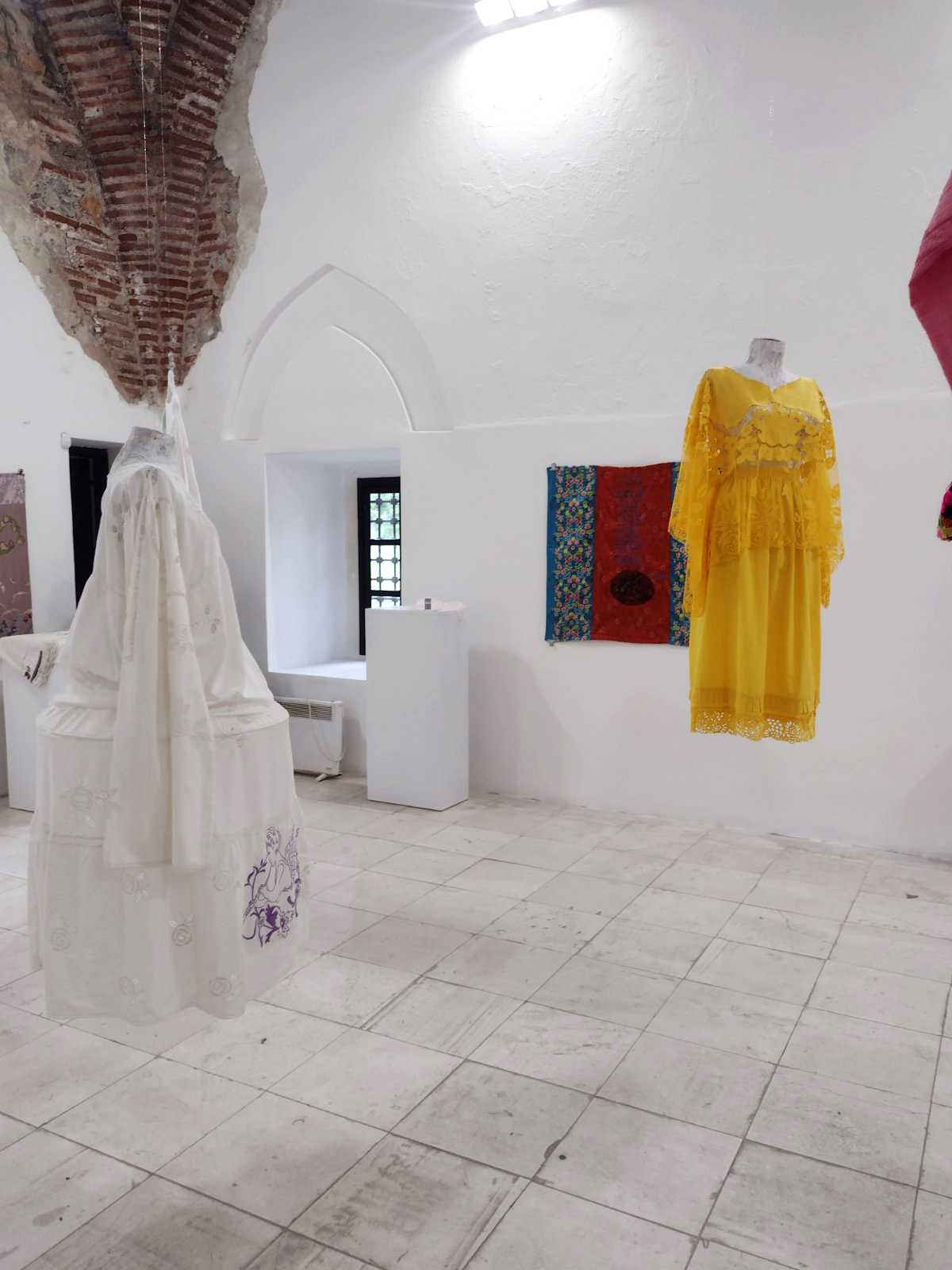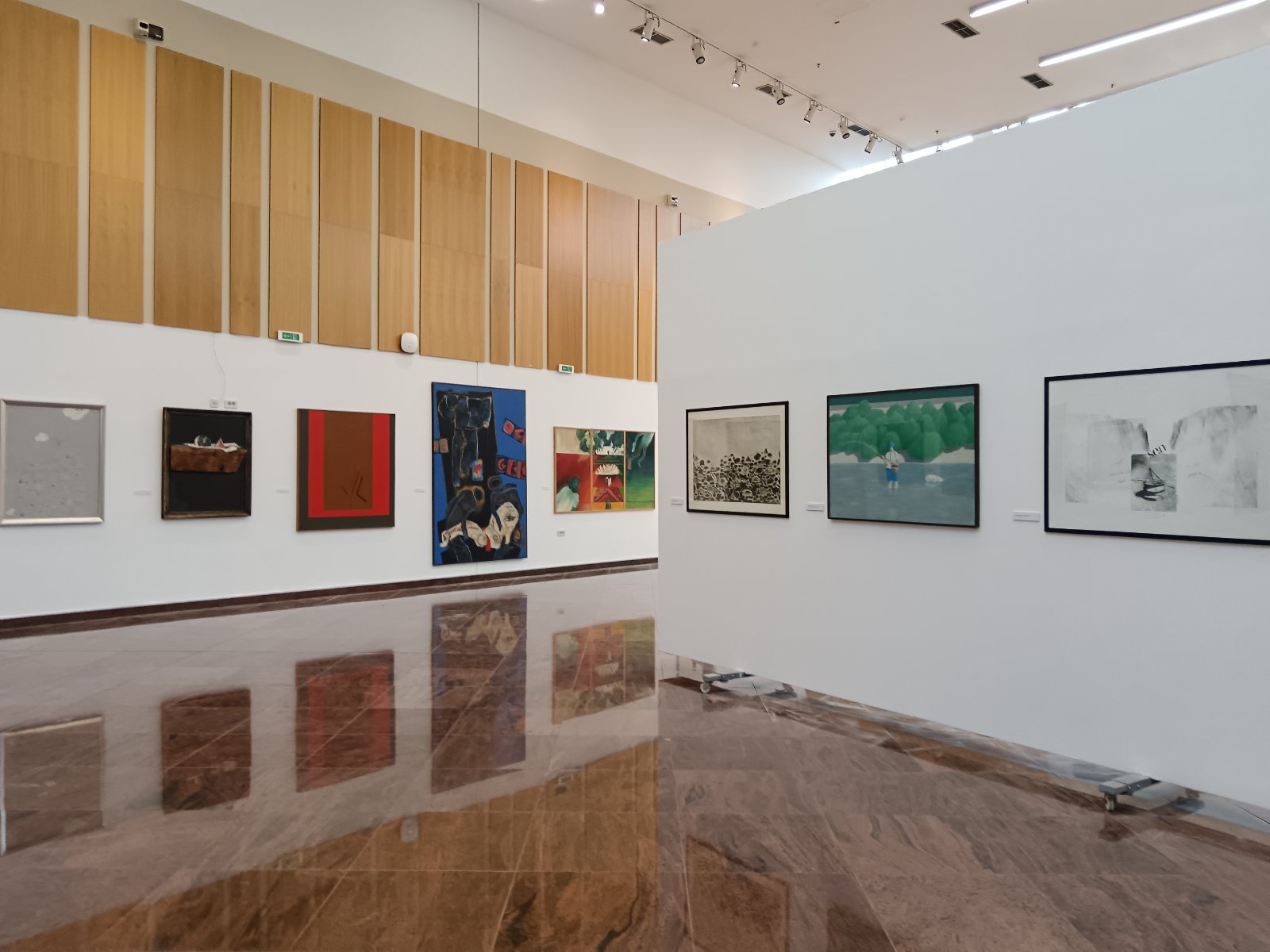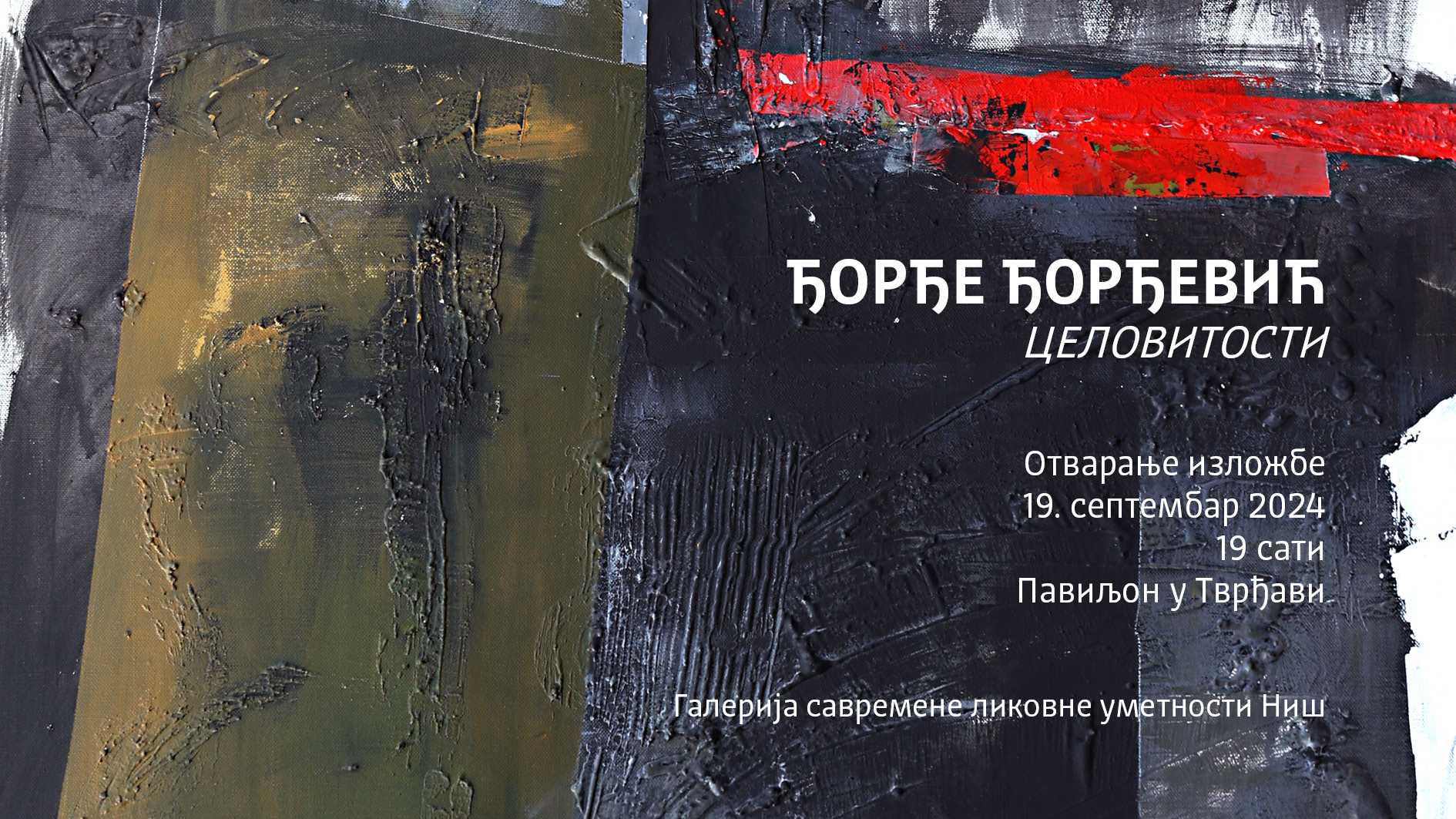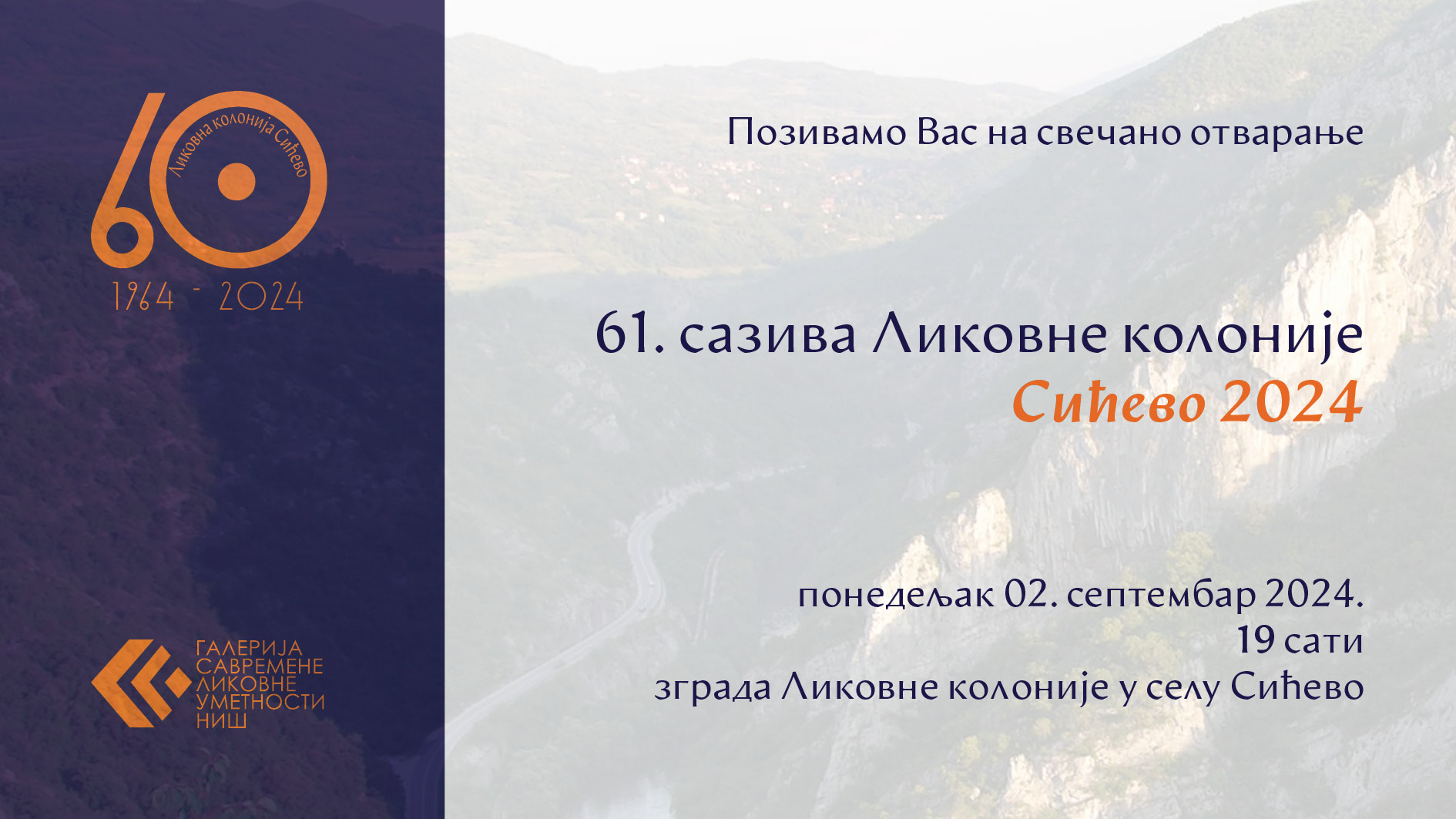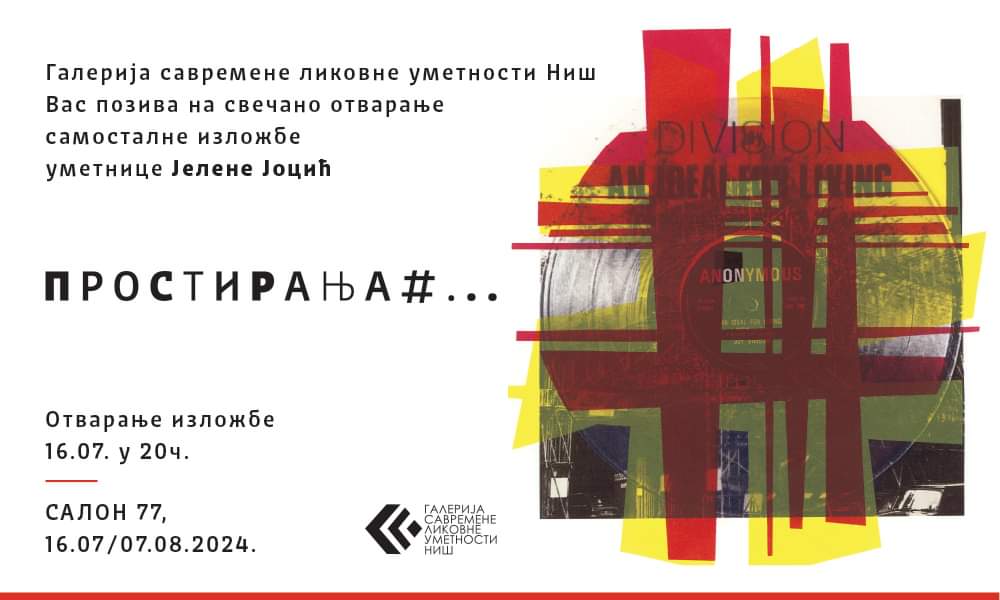АКТУЕЛНО
SELMA ĐULIZAREVIĆ EXHIBITION
SELMA ĐULIZAREVIĆ EXHIBITION
Selma Đulezarević – Karanović was born in Sarajevo in 1967. She studied at the Department of Art History at the Faculty of Philosophy in Belgrade. She graduated from the Painting Department of the Faculty of Fine Arts in Belgrade, in the class of Professor Milica Stevanović. She also completed her postgraduate studies at the same faculty in 1997. She earned a Doctor of Arts degree in painting under the mentorship of Professor Anđelka Bojović in 2012. She has been a member of ULUS since 1995. She currently works at the Faculty of Applied Arts in Belgrade as a full professor. She has had 34 solo exhibitions in Serbia, Montenegro, Bosnia and Herzegovina and Belgium. She has participated in numerous group exhibitions in the country and abroad. Her works are in the collection of the Belgrade City Museum, the Nadežda Petrović Gallery in Čačak, the Contemporary Gallery in Subotica and the Art Gallery of Bosnia and Herzegovina in Sarajevo.
In 2010, Selma Đulezarević Karanović participated in the Symposium of the International Organisation of Scenographers, Theatre Architects and Technicians in Istanbul, entitled Cultural Exchange Between East and West: Kaftan and Its Influence in Fashion. In the same year, she became a member of this organisation. The thematic framework of this symposium had a stimulating influence on her artistic work. Although she is a painter by vocation, she began researching the kaftan, a traditional shirt of the peoples and nationalities from the territory of the former Yugoslavia. Since the author herself comes from Bosnia and Herzegovina, more precisely from Sarajevo, she places emphasis on the urban costume, noticing various depictions and ornaments on the shirts of women of Jewish, Muslim and Christian faiths. One thing was common to all of them, and that was the beauty in the execution of various embroideries and weavings, as well as the dominant floral motif (rose, jasmine, tulip, lily of the valley,..). The importance of folk handicrafts, the richness of weaving in cotton, hemp and silk as well as embroidered decorations on clothing items, shirts, dresses, towels are sublimated in the new opus of Selma Đulezarević Karanović. Following the basic formal principles and patterns in the original embroidery, the artist paints and draws with textile paint floral decorations, song lyrics and messages. Collages made by combining different pieces of textiles have a special charm. This encounter of antiquity with objects of modern clothing creates new horizons not only of the aesthetic but also of the mental concept of a personal nature. The artist uses the white shirt from the folk costume as a metaphor for the permanent and the imperishable, as a symbol of the unbreakable bond of every woman with her mother, grandmother, great-grandmother, generations ago. As the artist herself says, with these works she makes a special kind of gratitude to our ancestors from whom we inherited a sense of beauty. We can freely say that our grandmothers turned manual labor from an everyday necessity into an individual pleasure and a means of expression. Women in domestic conditions, excluded from any socio-political influence and public life of that time, through this type of activity become the forerunners of today's emancipated women. Through various status or romantic messages ("Beauty is within us", "Housewives, talk less so your lunch doesn't burn", "Dew fell on the meadow, I gave my beloved my hand"...) Selma parries the traditional and contemporary position of a business woman, exposed to new global challenges. She has written the verses of Vera Nedić on her wedding towels, her shirts are called "Covid Depression", and her corsets are written with the names of antidepressants. Dresses, collages and other objects make the ambient installation entitled "Heritage-Burden" complex and multi-layered. Going through each segment of the aforementioned works, the artist gives us the opportunity to experience the past and heritage through the prism of the aesthetic, philosophical, material and immaterial segments of our individual and collective heritage, questioning our willingness to accept its weight.
https://www.youtube.com/watch?v=H_uPe1z9XnA
100 out of 1000 works from the collection of the Art Colony Sićevo
The second exhibition of the exhibition "100 out of 1000 works from the collection of the Sićevo Art Colony" will be available to the public from Thursday, September 19, at 10 a.m., at the Officers' House in Niš. The exhibition is of an international nature and consists of works created in the Colony between 1994 and 2024.
The Gallery of Contemporary Fine Arts Niš is organizing the exhibition "100 out of 1000 works from the collection of the Sićevo Art Colony" to mark the sixtieth anniversary of the regular holding of the Colony. The exhibition is designed to follow the chronological sequence of the Colony's existence, illustrating its basic characteristics (Yugoslav and international character, participation of artists of different vocations and stylistic orientations). Due to its large scale, the exhibition is being realized through two exhibitions. The first exhibition (from 29. 8 to 13. 9.) was of a Yugoslav character and included works created during the first three decades of the Colony. The second exhibition is of an international character, since since the beginning of the 1990s, artists from abroad have regularly participated in the work of the Colony. The exhibition is based on works by authors from Serbia and other countries (Japan, Canada, Sweden, Bulgaria...), which were created in the period from 1994 to 2024. The exhibition is also multimedia in nature, because in addition to works of traditional media (paintings, graphics, drawings), objects, video works and video installations are represented, since in the last couple of decades, artists who express themselves through the so-called new media have also been participants of the Colony.
The landscapes of the unique Sićevačka Gorge are a dominant inspiration and a constant artistic challenge for numerous authors. Each of them moved along the selected paths of their own visual poetics in the artistic re-creation of their experience of the gorge, using as an initial impulse a general impression, a panoramic view or just a fragment from nature (Kosta Bradić, Milena Jevtić Nićeva Kostić, Rada Selaković, Zoran Vuković, Miroslav Anđelković, Elizabeth Matje, Kenji Nagai, Branko Nikolov, Sonja Vukašinović, Rajko Popivoda, Jelena Šalinić, Due Martin, Katarina Đorđević, Ivana Stanković, Miroslav Lazović, Slavica Curk, Ljiljana Šunjevarić, the DimTim group...). A number of artists defined their impressions of their stay in the Colony through the symbols of the historical heritage of this region (Čedomir Vasić, Branimir Karanović, Zoran Grebenarović, Jelena Trajković, Vesna Knežević), while others, through works created in Sićevo, pointed to the antagonisms of current geopolitics, social reality, health situations or behavioral psychology (Zlatko Glamočak, Nina Kovačeva and Stefan Valentin, Zoran Veljković, Ivana Ivković, Milica Ruzić, Jovan Spasić, Ivan Milenković).
The author of the exhibition is Milica Todorović, museum advisor.
The exhibition will run until October 10.
Over the sixty years of regular maintenance of the Sićevo Art Colony, an impressive fund of artistic works has been formed, which currently has exactly 1,000 inventory units, of which 88 are kept in the National Museum and 912 in the fund of the Gallery of Contemporary Fine Arts. The most numerous in the collection of the Sićevo Art Colony are paintings (644), followed by graphics, drawings and works on paper (291), sculptures (33), photographs and works of new media (22).
https://youtu.be/jNuIHqy-Mfs
Djordje Djordjevic "Integrity"
Đorđe Đorđević "Integrity"
September 19 – October 14, 2024
After a long time, the artist Đorđe Đorđević will present himself to the public in Niš with an exhibition of paintings, entitled "Integrity". The exhibition consists of works from his current artistic production, including a number of this year's paintings. The exhibition will open on Thursday, September 19 at 7 p.m. in the Pavilion in Tvrđava.
Starting from the mid-1980s, Đorđe Đorđević's abstract painting opus has developed consistently, recording subtle shifts in terms of reducing the palette and repertoire of graphic symbols. Emphasizing the mental and emotional-expressive qualities of Đorđević’s creative personality, art historian Jovan Despotović notes his ability to disregard rules: “It allows him to maintain the pictorial scene in a consistent state in a justified compositional order, despite the risky process of crossing mutually exclusive principles of geometricism and gesturality in the same pictorial field…”.
With his recent painting, Đorđević offers resistance to the deafening hustle and bustle of everyday life. The basic element and unit of these compositions is the quadrangle, which embodies stability and harmony, but also neutrality and subordination to a larger whole. The gesturally treated surfaces, in comparison with the smaller monochrome fields, reflect the artistic principle of the unity of elements and the dominant, and this is also the thesis that the author examines on a semantic level. Therefore, transferred to the field of social relations, it is the principle of collective interests, which implies the discreet correction of the individual desires of the participants, the conscious surrender of part of personal dignity for the sake of the integrity of the community. In his autopoetic text, Đorđe Đorđević emphasizes that catholicity is an acute social need of the time in which we live.
Đorđe Đorđević was born in 1949 in Belgrade. He graduated from the Accademia di Belle Arti di Brera in Milan, Italy, in 1972. From 1974 to 1976, he designed textiles for the leather and textile factory "Viteks" in Visoko, near Sarajevo. He held twenty-five solo exhibitions in Serbia, Italy, Croatia, France, Montenegro and Austria and took part in a large number of collective exhibitions. His works are represented in several public and private art collections. He has been a member of ULUS since 1981, and in 1982 he received the status of an independent artist. He lives and works in Belgrade.
https://www.youtube.com/watch?v=zNAAxyzg2mc
''Ослобађање'' Маше Пауновић
Као скулптор који улази у сам срж материјала било да је у питању дрво, камен или метал са великом пажњом се посвећује динамичном обликовању заробљених емоција.
Свака од њених скулптура егзистира као аутентичан, живи организам који се налази у стању преобликовања или трансформације тежећи да се повеже са простором, док истовремено емитује јединствен облик енергије.
Артикулишући нове енергетске вредности не само да успоставља везу са посматрачем него и генерише нове просторно визуелне садржаје проблематизујући актуелне теме савременог друштва.
Излаже на колективним изложбама од 2002. године и учествовала је на преко 100 колективних изложби у земљи и иностранству а такође је имала до сада 8 самосталних изложби:
Art Colony 61st convocation
Art Colony Begins: Artists Create in Sićevo for the Next 10 Days
Last night, the 61st convocation of the oldest art colony in the Balkans was officially opened in the village of Sićevo, where 9 artists from Croatia, Bulgaria and Serbia will be staying for the next 10 days. The artworks created during this year's event will be exhibited in the Pavilion in the Fortress in November 2025.
The Sićevo Art Colony continues the tradition of the first Yugoslav art colony, founded by the famous Serbian painter Nadežda Petrović.
“We are opening this colony with special pleasure, because for us this is the year of the anniversary and 6 full decades of continuous maintenance of the Sićevo Colony. It took a lot of vision, commitment and enthusiasm to bring to life the idea that Nadežda Petrović had in 1905 when she first gathered her colleagues here in the village of Sićevo. Thanks to this, our institution has over 900 paintings, sculptures and new media that we preserve, study, take care of, and occasionally exhibit, and these are works by over 500 authors from our country and abroad,” says Ema Ćoćić Bilić, director of the Gallery of Contemporary Fine Arts.
The opening ceremony was also attended by Prof. Dr. Dejan Antić, State Secretary at the Ministry of Culture, who emphasized his unique position on supporting this significant cultural event.
"It is an honor and a pleasure to be with you tonight. I would like to take this opportunity to convey to the director and all of you the position of Minister Nikola Selaković that the state of Serbia and the Ministry of Culture will continue to support the organization of such a colony. The Ministry has supported the realization of the Colony continuously in previous years, and it will continue to do so in the years ahead," says Prof. Dr. Dejan Antic, State Secretary at the Ministry of Culture. The collection of works of art created in Sićevo is the most valuable collection of our art from the second half of the century in the territory of Serbia proper, both in terms of its historical, artistic and aesthetic characteristics.
City Councilor Milica Paulus said that artists are the most important in a society, and she recalled the words of Nadežda Petrović.
“Artists must be teachers not only of their own people, but of all peoples. Not only of their own, but of all centuries. And true art must be a teacher, educator and fighter for the progress of humanity. We can say that the task and mission of artists and art have not changed to this day. In this name, I wish all participants a pleasant stay and successful work in this wonderful space where artists and nature compete in the beauty of colors and shapes,” says Councilwoman Milica Paulus.
The participants of the Sićevo Art Colony 2024 are: Nina Ivanović, Marija Bogdanović, Đorđe Stanojević (Belgrade), Nikolija Stanojević, Milan Hrnjazović (Valjevo), Borislav Božić (Croatia), Dinko Nenov (Bulgaria), Milan Ristić and Tijana Savković (Niš).
The implementation of this year's event was supported by the City of Niš and the Ministry of Culture of the Republic of Serbia.
Art colony Sićevo 2024.
The Gallery of Contemporary Fine Arts Niš invites you to the grand opening of the Art Colony Sićevo 2024 on Monday, September 2nd at 7 p.m. - Art Colony building in the village of Sićevo.
The Art Colony Sićevo continues the tradition of the first Yugoslav art colony, founded by the famous Serbian painter Nadežda Petrović. As the oldest colony in the Balkans, it was first held in 1905. Since 1964, when its work was renewed, it has been held continuously every year. Thanks to this event, a collection of 1,000 works of art has been formed and, in terms of its historical, artistic and aesthetic characteristics, it is the most valuable collection of our art from the second half of the century in the territory of Serbia proper.
The colony is held every September in the village of Sićevo, 20 km from Niš. In addition to the artists' stay and work, the Work Program, decided by the Event Council, traditionally includes a more detailed introduction of participants to the cultural and historical heritage of this region. During the ten-day stay, participants have the opportunity to visit the Sićeva Gorge, the surrounding monasteries, and the cultural and historical monuments of our city: the Fortress, Mediana, and the Ćele-kula.
The works of art created during this year's event will be exhibited in the Pavilion in the Fortress in November 2025.
The collection of the Sićevo Art Colony is enriched every year with new works that are left for safekeeping, museological processing, protection, and professional presentation in the implementation of the Gallery of Contemporary Fine Arts in Niš.
The participants of the Sićevo Art Colony 2024 are: Nina Ivanovic, Marija Bogdanovic, Đorđe Stanojevic (Belgrade), Nikolija Stanojevic, Milan Hrnjazovic (Valjevo), Borislav Bozic (Croatia), Dinko Nenov (Bulgaria), Milan Ristic and Tijana Savković (Niš).
The implementation of this year's event was supported by the City of Niš and the Ministry of Culture of the Republic of Serbia.
100 out of 1000 works from the collection of the Art Colony Sićevo
On Thursday, August 29 at 8 p.m., the Officers' Home opened the exhibition "100 out of 1,000 works from the collection of the Sićevo Art Colony" to mark 60 years of regular operation of the Colony.
The exhibition is conceptually designed to follow the chronological sequence of the Colony's existence, illustrating its basic characteristics - Yugoslav and international character, openness to artists of different vocations and styles. The exhibition will be realized through two exhibitions, the first of which is based on works created until 1994, and the second exhibition (September 19 to October 10) includes works from the last thirty years. The author of the exhibition is Milica Todorović, museum advisor.
As the participants of the Sićevo Art Colony were protagonists and actors of numerous parallel existing movements and styles, the exhibition also provides insight into recent movements in art in our region from the 1960s to the present, i.e. from Informel and Tachism, oneiric and metaphysical painting, new figuration, various retro styles of the 1980s and postmodern tendencies, to a new understanding of classical painting and electronic painting, i.e. video.
The idea of our famous Serbian painter Nadežda Petrović about gathering artists in Sićevo, which was realized in 1905 within the First Yugoslav Art Colony, was renewed in 1964 at the initiative of the Society of Fine Artists of Niš, with the establishment of the Sićevo Art Colony. At the time of its establishment, the Sićevo Colony was the first art colony in the territory of central Serbia, and today it is a respectable and longest-running art manifestation of the city of Niš, highly respected in the art world.
The Sićevo Art Colony was initially Yugoslav in nature, and since 1982 it has officially acquired the character of an international manifestation, but inviting artists from abroad has become a regular practice since the early 1990s. A total of 545 artists have participated in the work of the Sićevo Colony so far, of which the largest number were artists from Serbia (285), Niš itself (80), the former Yugoslav republics (70), while 110 artists from many European countries and countries from other continents participated.
In line with the First Yugoslav Art Colony, whose prominent member was the sculptor Ivan Meštrović, the Art Colony Sićevo was open from its foundation not only to painters but also to sculptors and graphic artists, which distinguished it from the colonies of the time that were exclusively for painting (Ilok, Senta, Ečka, Počitelj) or sculpture (Portorož, Dečani, Prilep). Thanks to the Art Colony Sićevo, an impressive fund was formed, which currently has exactly 1000 works of art, of which 88 are kept in the National Museum in Niš and 912 in the collection of the Gallery of Contemporary Fine Arts, given that the Gallery has been managing all the work of implementing the Colony since its foundation (1970). The collection of the Art Colony "Sićevo" is a large, authentic and, due to its historical and artistic characteristics, extremely valuable collection of contemporary art.
Although the organizers of the Colony never conditioned or limited the artists in terms of their choice of themes and motifs, a large number of authors directly reacted to the environment in which they created with their work, whether they used the historical and cultural and artistic heritage of this region for their own inspiring mimesis or the natural environment itself, that is, the landscapes of the unique and unrepeatable Sićevo Gorge. Transposing the vital force of powerful nature into the language of visual elements was a challenge that many artists could not resist, approaching it in an inventive way while respecting personal artistic subjectivity.
The exhibition 100 out of 1000 works from the collection of the Sićevo Art Colony contains works by artists of a wide generational range, from Ivan Tabaković and Mihailo Petrov through the generation of Miodrag Protić, Ksenija Divjak, Mića Popović, Boško Karanović, Bate Mihailović, Stojan Ćelić, Leonid Šejka to all subsequent generations and artists active today. Although the exhibition is based on only one tenth of the works from the collection of the Sićevo Colony, we believe that it provides an adequate insight into the value of the collection, with it we mark the sixtieth anniversary of the Colony's existence, but we also remind you that this priceless treasure still does not have the conditions for permanent presentation.
"Trepča" by Ljiljana Šunjevarić
Trepča by Ljiljana Šunjevarić.
Ljiljana Šunjevarić's latest artistic ensemble will be exhibited for the first time in Niš, at the Pavilion in Tvrđava from August 22 to September 15. With these paintings, the artist remains consistent with issues of social reality, but makes perhaps the first more extensive contribution to understanding the living conditions in northern Kosovo in domestic art. The Trepča Mining Complex, which symbolizes the betrayed ideas of socialist workers' progress, indirectly tells us about the policy of restoring Serbia's sovereignty over the province, from the late 1980s and the more than excessive epilogue from the 1990s. However, Ljiljana's paintings mostly thematize the twenty-year transitional vacuum in this territory, the issues of people's lives and endless expectations. Therefore, the artist paints vedutes of this complex in a hilly landscape, genre scenes from the Trepča restaurant, and portraits of the staff and its guests in muted tones. With the Trepča exhibition, Ljiljana Šunjevarić makes precise but open artistic observations and thus provokes a response from the public consciousness.
Ljiljana Šunjevarić was born in 1979 in Užice. She graduated, received her master's and doctorate in painting from the Faculty of Fine Arts, University of Arts in Belgrade. She has been actively exhibiting at solo and group exhibitions in the country and abroad since 2000. She has been awarded in the field of drawing. She is the author of several art projects in public space. She has participated in numerous domestic and international art colonies and workshops. Her works of art are represented in many collections: Collection of Paintings / Period after 1950 of the Museum of Contemporary Art in Belgrade; Collection of Contemporary Art of the Nadežda Petrović Gallery in Čačak; Collection of the Gallery of Contemporary Art in Zrenjanin; Collection of the National Museum in Arandjelovac; Collection of the National Museum in Smederevo; Collection of the City Museum of Belgrade; Collection of the National Museum in Kraljevo; Collection of Contemporary Painting of the Gallery of Contemporary Fine Arts in Niš and in several private collections. She is employed at the Faculty of Arts of the University of Pristina with a temporary seat in Kosovska Mitrovica, with the title of Associate Professor.
Sofia Vojinović "Daydreams"
Sofija Vojinović ''Dreaming''
SALON 77
Sofija Vojinović, born in 1991 in Čačak. She completed her master's and basic academic studies at the Faculty of Fine Arts in Belgrade, Department of Painting. She is a member of ULUS.
She has participated in several group exhibitions and has realized four solo exhibitions in Užice, Belgrade, Čačak and Kragujevac. Since 2018, she has been starting her exhibition career with drawings in which she explores the shadow. This project has resulted in the cycles Presupposition, Home in the Home, Shadows of Home and the latest Dreaming.
The shadow in Jung's psychology of personality has a deep meaning and the term shadow refers to a part of identity that the conscious self does not understand or accept. Psychic traits that the human ego does not recognize as its own are instead repressed into the unconscious, where an inferior, dark part of the personality called the shadow is formed. What is even more interesting is that the shadow is an inexhaustible source of creativity and often superb art. Shadows are also mentioned in fairy tales and children's stories, let's remember Peter Pan, the eternal boy who chases his mischievous shadow. The shadow can appear in visions, memories and dreams. That is why the artist turned her shadows into memories that, although faded, have remained permanently recorded in special folders and memory cards. A shadow on the wall, a shadow on the floor, a shadow from a window with outlined traces of a curtain through which, as the wind blows, patterns are created on the wall, outlines of silhouettes, geometric and amorphous forms like the shadows of a home. This interweaving represents the memory of childhood, events from the past, beautiful unforgettable moments experienced in youth, in life, but also repressed difficult, emotional moments that occasionally surface.
The latest cycle of Daydreaming builds on previous cycles, shadows revive memories, and new fragments remain framed within the drawing, frozen in time. Daydreaming is a characteristic of artists, poets, inventors, philosophers. Many scientific achievements, imaginary landscapes of visual artists, beautiful symphonies of composers can arise from daydreaming. They have the power to materialize their daydreaming and transform it into a painting, music, or song.
Shadows on walls, drawings, and canvases by Sofija Vojinović represent geometric compositions with a pronounced perspective, painted in gray layers of transparent paint with visible overlapping of crossed lines and surfaces. Discreetly presented combinations of vertical and horizontal surfaces, bordered by a shadow through which light passes, create a certain contrast that is very important in fine art. This contrast enhances the excitement of the composition. However, the artist places special emphasis on the shadow, which is dominant in the entire composition. Judge for yourself whether visualization is the only important thing or the artist is just playing around in order to draw our attention to listening to our Self a little better, and accepting it as it is without any restraints or complexes.
Spreads # ...
JELENA JOCIC EXHIBITION: "PROSTIRANJA"
"SALON 77" /July 16 - August 7/
She was born in Belgrade in 1970. She graduated from the Faculty of Fine Arts in Belgrade in 1997, at the Department of Graphics, received her master's degree in 2000, and received her doctorate and the title of Doctor of Arts at the Faculty of Fine Arts within the University of Arts in Belgrade in 2017. During her undergraduate studies, she was a recipient of a scholarship from the Republic Foundation for the Development of Scientific and Artistic Youth of Serbia. In the period from 1998 to 2002, as part of a project for talented individuals, she worked at the Department of Graphics at the Faculty of Fine Arts in Belgrade.
Since 2003, she has been working as a professor of professional studies at the Academy of Professional Studies Polytechnic, at the Department of Design. So far, she has had several solo exhibitions and over two hundred group exhibitions in the country and abroad. She has exhibited in New York, Paris, Luxembourg, Liege, Quebec, Thessaloniki, São Paulo, Seoul, Madrid, Budapest, Istanbul, Stockholm, Skopje and at many international graphic arts biennials and triennials. She is the winner of several awards in the field of graphic art (Petar Lubarda, Đorđe Andrejević – Kun, 8th and 9th Biennial of Yugoslav Student Graphics).
The most significant awards in the field of graphics are:
The Graphic Collective Mali Pechat Award in 2010 and the Veliki Pechat Award in 2021. The work "Bridges" is in the collection of the Belgrade City Museum. Her works are included in the Purchase of Works of Art of the Ministry of Culture and Information of the Republic of Serbia (2005, 2014, 2015, 2016, 2018). She has been a member of the Association of Fine Artists of Serbia (ULUS) since 1998, and on the board of directors of ULUS from 2022-2023. She has been a member of the Artistic Council and the board of directors of the Grafički kolektiv Gallery in Belgrade since 2011. She was elected as the president of the board of directors of the GK at the GK assembly held on 06.07.2023.
Jelena Jocić continues her artistic research, relating to the existing interiors of large industrial centers, finding in them the idea for defining an ideal space. By merging the visual and the perceptual into one whole, he develops a unique artistic language in whose context visions of an ideal space can be glimpsed. Through his own photographic observation, he singles out the dominant motif of empty, devastated industrial complexes, approaching the framing process that hints at transience, alienation and loneliness. Continuing the process of creation, in addition to nurturing visual relationships, the network of crossed lines and collage pop art pieces also includes a certain number of artifacts.
Through the play of light and geometric surfaces, as well as the assembly procedures used by constructivist artists, he explores the boundaries of personal and private space.
The architectural specificity of the interior, which associates with metal structures, served as a metaphor for the boundary that separates the artist from the existing environment, entering new timeless dimensions.
https://www.youtube.com/watch?v=Lb39KY7LJdE



